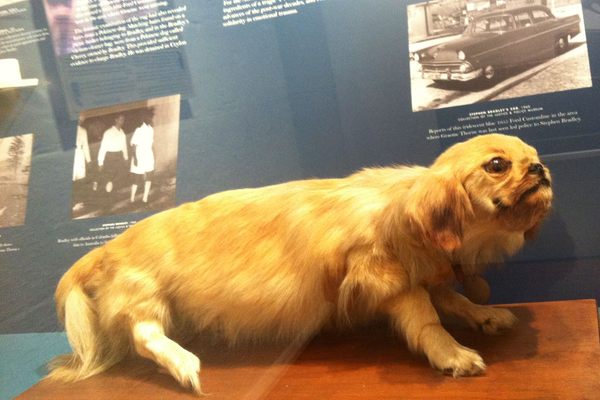Objects of Intrigue: The Electric Whaling Harpoon
Whaling illustration from “Narrative of the Wreck of the ‘Favourite’ on the Island of Desolation” (1850) (via British Library)
19th century whaling was brutal, bloody business, both for the whales and the men who set to the seas for months with metal harpoons in hand. A couple of Germans had an idea to modernize the industry: electricity.
The Electric Whaling Apparatus was patented on March 30, 1852 by Albert Sonnenburg and Philipp Rechten of Bremen, Germany. A model of this device is held by the Smithsonian’s National Museum of American History. Hal Wallace, associate curator of the Electricity Collections at the museum, shared with us the curious patent, as well as photographs of the preserved remains of the whale electrocution system.
1852 patent image for the “Electric Whaling Apparatus (via US Patent Office)
As Sonnenburg and Rechten explained in their patent, the Electric Whaling Apparatus was a “new and improved mode of catching and securing sperm and right whales, as well as other animals of the sea” by “the application of electric galvanic current conveyed by a conductor to the instrument commonly called ‘whale-iron’ or ‘harpoon,’ and which is used to be thrown into the fish.” The way it worked was through the power of a magneto-electric rotation-machine that was connected through a metallic wire to the harpoon.
To accommodate the hefty 350 pound device with its rotating coils, as well as protect the human user, it was all secured in a copper-lined whale-boat, assuring that “there is no possible personal danger in using our machine or apparatus, except [if] the man who throws the whale-iron take the metallic part of it into one hand and put the other hand at the same time into the sea when the machine is in motion.” When the harpoon hit whale flesh, it pounded eight shocks into the mammal, “so formidable a power that no living being can resist the same.”
Electric current, mammals that weigh tons, water… what could go wrong? Yet surprisingly the Electric Whaling Apparatus was implemented. Smithsonian curator Shari Stout shared a selection from Harpoons and Other Whalecraft by Thomas G. Lytle published by the Old Dartmouth Historical Society Whaling Museum in 1984. The book cites a skeptical June 8, 1852 article in Whalemen’s Shipping List, and Merchant’s Transcript stating: ”We have great doubts of the feasibility of the project, but of course the result can only be obtained by actual experiment.” And just the next month on July 5 the same publication printed a letter from Bremen reporting from an expedition:
“Thus we had but one chance to try the experiment upon a whale, which was made with the four magnet machine. The whale upon being struck made one dash onward, then turned on his side and was rendered perfectly powerless. Although I have as yet not been fortunate enough to test the invention in more instances, I have the fullest confidence in the same, and doubt not to be able to report the most astonishing results on my return from the Arctic Seas, where I am now bound.”
The Electric Whaling Apparatus at the Smithsonian (courtesy Smithsonian’s National Museum of American History, Electricity Collections, Catalog #336747)
Inside the machine (courtesy Smithsonian’s National Museum of American History, Electricity Collections, Catalog #336747
The Electric Whaling Apparatus didn’t take hold, though, and for a long while the fusion of electrocution with the salty ocean was set aside. But the quest for shocking the great whale to death didn’t disappear. According to a 1952 article by Robert Clarke of the National Institute of Oceanography, electric harpoon experiments were carried out in 1881 and 1904, but weren’t successful until 1929 when another German by the name of Weber headed a team that electroctued four fin whales. By 1938 the device was “said to have accounted for about two thousand whales during six expeditions north and south.” Unfortunately, as Clarke explains, the details are slim as “Weber committed suicide in 1945,” although “some account of his methods has been published. Then in the 1950s there was renewed interest in the United Kingdom where in 1958 the Lords in the UK Parliament had a debate in which it was argued that in the electric method ”the whale dies much more rapidly,” and was therefore less cruel.
Although 19th century whalers never did get to the point of jolting their prey to death, it would have arguably been quicker and less gory than the repeated stabbing of the whale into its miserable fate. Nevertheless, it’s probably for the best both for human and whale alike that seafaring folk in the 1800s weren’t tossing electrical weapons into the water around them.
courtesy Smithsonian’s National Museum of American History, Electricity Collections, Catalog #336747
Thanks to Hal Wallace, associate curator of the Electricity Collections, and the National Museum of American History for sharing the Electric Whaling Apparatus with Atlas Obscura. For more on electrical oddities visit the museum’s blog for such articles on as the story of Samuel Morse and Morse code, a 19th century electrical switch with a tale of averted tragedy, and the technology that brought the news of President John F. Kennedy’s assassination.
Objects of Intrigue is a feature highlighting extraordinary objects from the world’s great museums, private collections, historic libraries, and overlooked archives. See more incredible objects here >
curator Shari Stout























Follow us on Twitter to get the latest on the world's hidden wonders.
Like us on Facebook to get the latest on the world's hidden wonders.
Follow us on Twitter Like us on Facebook